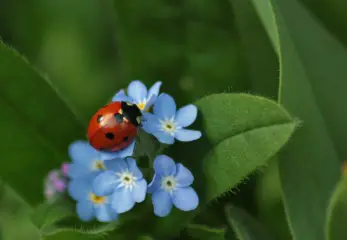There’s an urban myth about ladybugs that you can tell how long an adult ladybug will live by counting their spots. I started wondering how long do ladybugs live, and brought together a lot of data.
Unfortunately, you can’t tell how long they’ll live by their spots. If you’ve ever found a 24-spotted Ladybug then I assume you figured this out. A ladybug living 24 years would be some achievement!
So, how long do ladybugs actually live?
The average life expectancy of a ladybug is actually 1-2 years. Their life cycle goes through various stages from egg, larvae, and pupa to adult. However, the actual life expectancy depends on a variety of factors including weather, food, water, and predators.
Let’s see how these affect their life cycle.
Now that we know about their life expectancy, how about we discover some more about their life, what they eat, how they live, and why are they called Ladybugs? And I’ll talk you through the life stages of the Ladybug too.
Ladybugs Are Not Bugs!
Ladybugs aren’t actually bugs. They belong to the beetle family which is characterized by their hard shells. The shells hide their wings. In fact, ladybugs (or ladybirds) also don’t have beak-like mouths which are typical of ‘bugs’.
Plus Bugs are known to suck nutrients from various other plants and beings. Whereas Beetles will chew using their jaw or pincer-shaped mouthparts.
Ladybugs or ladybirds, as they are called, got their name some 500 years ago. Farmers were frustrated by pests that infested their crops. These insects, called aphids, were sucking the juices from the grape vines.
But, there’s always a savior…
The farmers being Catholic prayed to Virgin Mary for some divine intervention. Lo and behold, the ladybugs arrived.
They kept the pest population in check and allowed the plants to grow. In honor of the Virgin Mary, the farmers named them “Our Lady”, and “The Beatles of Our Lady” and slowly the names took a colloquial detour to find their current name, the Ladybug.
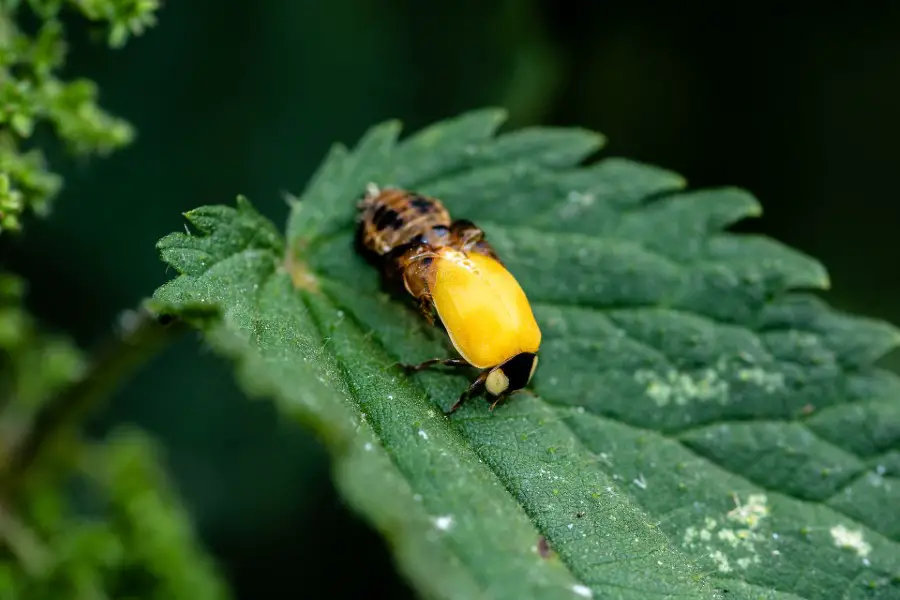
The Complete Ladybug Life Cycle
These small insects belong to the Coccinellidae family and genus Hippodamia. There are as many as 5000 different species of ladybugs that can be found around the world. They range in length from 0.3-0.4 inches, which is about one-third the length of a paperclip.
Scientific Classification
- Kingdom: Animalia
- Phylum: Arthropoda
- Class: Insecta
- Order: Coleoptera
- Suborder: Polyphaga
- Superfamily: Cucujoidea
- Family: Coccinellidae (Typical Ladybug!)
There are then a number of subfamilies…
- Chilocorinae Mulsant, 1846
- Coccidulinae Mulsant, 1846
- Coccinellinae Latreille, 1807
- Epilachninae Mulsant, 1846
- Hyperaspidinae Duverger, 1989
- Microweiseinae Leng, 1920[2]
- Scymninae Mulsant, 1846
- Sticholotidinae Weise, 1901
Number and Types of Species
There are approximately 5000 species of ladybugs currently found across the world. They are generally round or in a semi-circular shape. They have short limbs and small heads. The antennae on their head are not very long either.
While we’re used to imagining ladybugs as red in color, they can also be bright orange. The color and variation of spots on their back vary from species to species.
These variations have produced all manner of colors, from Yellow
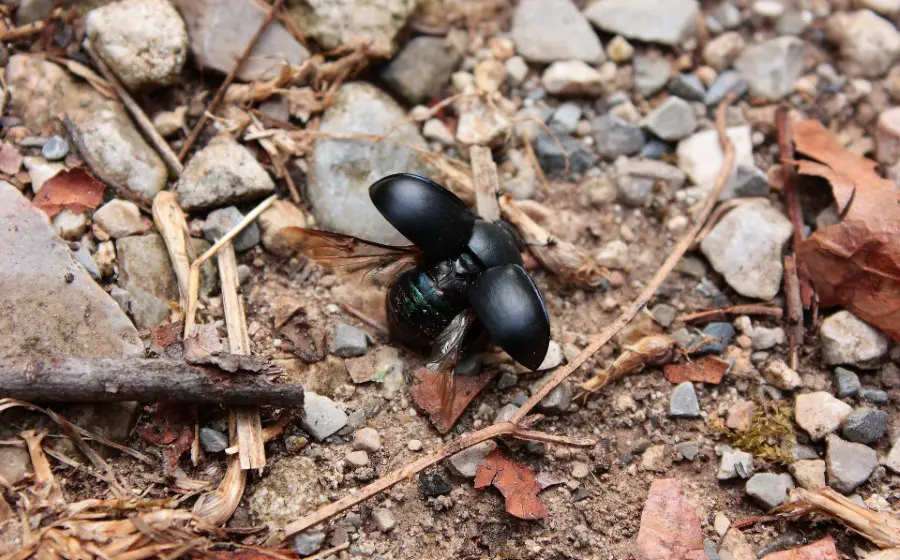
Ladybirds with different habits, such as those that eat only plants and fungi. And some that are more aggressive by nature.
The spots have particular usage. The color and the spots make them unappealing to predators, thereby ensuring their survival in the wild. They also secrete a fluid from their leg joints which emits a strange smell and a foul taste for predators who try to eat them.
Most insects have a four-stage life cycle. The ladybugs are no different. In fact, their lifecycle is quite similar to that of butterflies.
There are four stages. After the egg hatches, the alligator-like larva appears. The larva must then work towards and metamorphose into a pupa and then whilst in this state they develop into an adult ladybug.
When Do Ladybugs Mate
Typically, Ladybugs will begin mating shortly after they come out of hibernation (known as diapause). They will usually spend the first month or so feeding heavily in order to return their body energy reserves to normal after the long winter months.
Once they are well fed, they will turn their attention toward mating. Around May (Northern hemisphere) is when you will typically see Ladybugs mating.
To learn about mating for Ladybugs, I wrote a complete article on that here, called When Do Ladybugs Mate? Ladybug Mating and Reproduction Process, based on when and how they mate. Here, we’ll look at what happens once the female comes to lay her eggs.
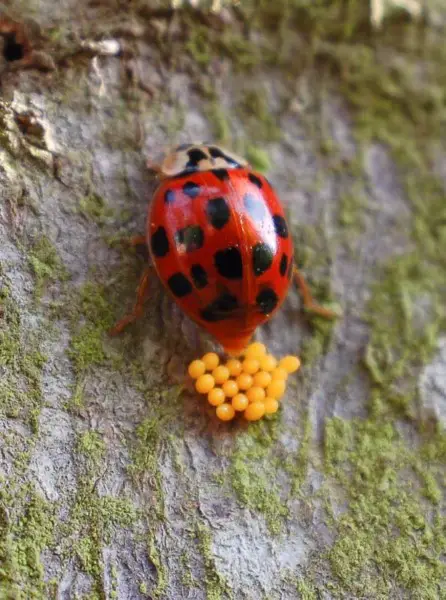
Ladybug Egg Stage
In the egg stage, the ladybug first comes to life after two adults have mated. The females lay the eggs on a plant that will provide a good food source for when the offspring hatch.
The eggs are generally laid on the underside of the plant’s leaves, so as to protect them from rain, wind, and any would-be predators.
The eggs are bright yellow in color and at this stage show no sign of the final form. They will typically hatch around 5-7 days after they were produced. During the final 1-2 days before hatching, eggs will turn a visible grey color.
Following is footage of an actual ladybug laying her cluster of eggs.
Females do not wait after laying eggs and certainly do not nurture their young. Once egg laying is complete they will start the process all over again. Males play no part beyond mating with females.
Here’s how to tell the difference between ladybug males and females.
The females lay eggs in the spring (northern hemisphere). They could lay up to 300 eggs after one mating. Usually, in clutches ranging from around 12-20 eggs.
To ensure that the newborns can find a sustainable food source, the female will place the eggs near an aphid colony. Aphids are one of the natural food sources for ladybugs. Soon enough, in around 5-7 days the eggs will hatch.
A single female can produce up to 1000 eggs in one mating season. Some species of coccinellids – Ladybugs are believed to lay additional infertile eggs alongside the fertile eggs, this is to provide a quick food source, for newly hatched larvae.
If their normal food source is more scarce at the point the eggs are laid, then more infertile eggs are likely to be laid alongside. This is not uncommon among ladybugs and other beetle species, it’s what’s known as ‘Trophy Eggs’.
Researchers believe that ladybugs can be both fertile and infertile in the cluster of eggs. Now, newborns have their own way of understanding which of them are fertile and which aren’t. If aphids are in short supply, the young Larva bugs will eat the infertile siblings to help them stay alive during those crucial first few hours.
The actual time when the Larva emerges from the egg varies on multiple factors including species, weather, and temperature. Based on these factors, the timeframe of 5-7 days could increase or decrease.
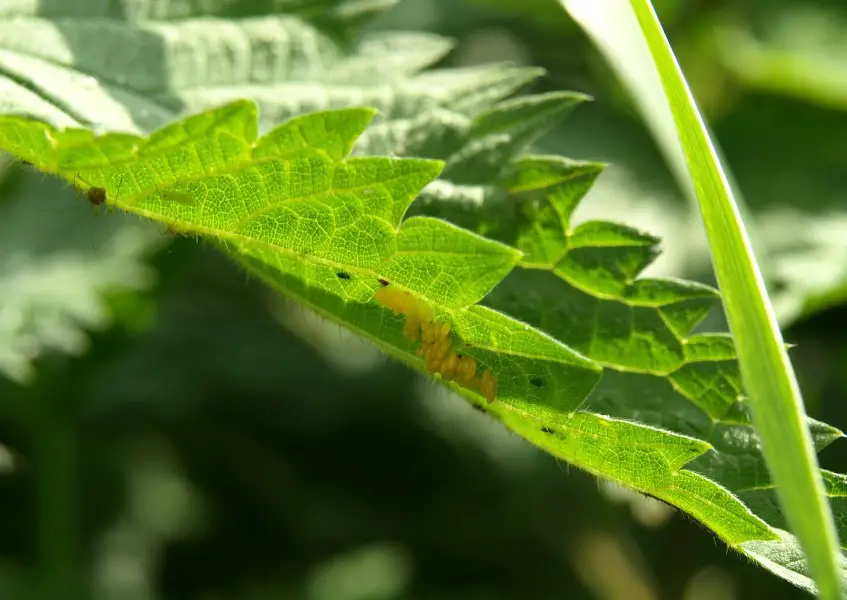
Ladybug Larva Stage
The small larvae look somewhat like extremely small alligators. They have long bodies and uneven almost spiky exoskeleton. In some species, the larvae are black and have brightly-colored spots or stripes of varying colors on their body.
They do not yet have wings, which occurs after the next stage. But they do have 6 legs which help them locate prey.
In the beginning, the broken egg shells and possible ‘trophy eggs’ can serve as the primary food source for the larvae as it rests from their ordeal and acclimatizes. Once they’re out of the shells, they soon become hungry and need to feed on something.
Thankfully, a mother knows…
The eggshells and trophy eggs are only part of the diet. Since they are often laid on a leaf that is part of their diet or near aphid or mite nests, they still have plenty of other things to feed on. At this stage, they need lots of food since they’ll need the energy to grow and move into the next phase.
A single larva can eat up to 75 aphids in a single day. In fact, they’re thought to be more hungry eaters than Ladybug adults – but then they are still young and growing.
Their food source will include other soft-bodied insects like mites, scale insects, adelgids, and even insect eggs. At this stage, they don’t really discriminate about what they’re eating.
The larvae stage typically lasts between 3-4 weeks depending again on available food sources and the individual growth rate of the Larva. A typical Larva will need to reach an ideal weight of around 15 milligrams in order to move on to the Pupa stage.
Ladybug Larvae will not mate whilst in the larval stage. Their sole task during this time is to grow as fast as possible to get to the Pupa stage.
During this time, they’ll molt their skin a number of times. After each growth stage, the larvae will shed their old skin. The new skin will be more elastic than the last and this process continues for quite a few times.
The time between the molts is known as an instar. The larvae will feed until it becomes too big for their current cuticle. At such a time, it will molt its skin. A larva will generally go through four instars before it moves on to the next stage in the life cycle, which is the pupal stage. When such a time comes, it will attach itself to a leaf and start to undergo transformation.
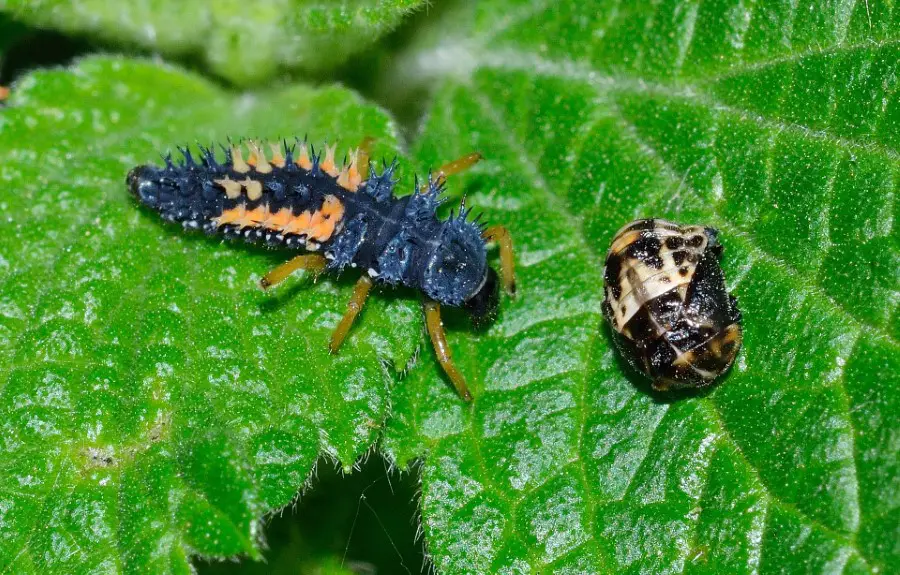
Ladybug Pupa Stage
The pre-pupa is ushered into the pupa stage. This is when the larvae start to stick themselves to a leaf. At this point, the larvae attach themselves belly-first and slowly cease all motions. It will stop eating and moving and after a while, it will even stop any wiggling motion.
Once it stops moving completely, it has entered the pupal stage. This stage can last between 3-14 days but usually, the larvae emerge as an adult after a week’s time.
All the food ingested during the larvae stage will help it to keep its energy levels as it slowly begins the transformation process. During this stage, the larvae are usually the largest they’re likely to be, up to about 0.6 inches (1.7cm)
The ladybug’s body will undergo a massive change at this point. The change is directed by specialized cells called histoblasts. The histoblasts direct a biochemical process that breaks down the larval body and starts work to build its new adult body.
Depending on factors like temperature, weather, and species, the duration of the pupal stage will vary. Slowly, the larva’s body will break down and it will emerge with a soft and wet exoskeleton.
At this point, the spots and colors will not be vivid. Slowly, as the exoskeleton dries and hardens the colors will become more distinct and vivid. The colors will vary based on the species of the ladybug.

After the Ladybug has matured to adult form within the pupa, it will begin to break out from the front of the pupa with the help of its mandibles.
Once it breaks out, the Ladybug is still quite vulnerable. It will need around 2 to 3 hours for its shell to harden and for its colors to take shape. I know as I’ve studied and documented this using the image below
The image shows the development of a new adult just after emerging from the Pupa and within a time scale of about 3 hours, with images taken approximately every 5 minutes. The time scale does depend on available sunlight and warmth.
Here you can see how its shell (elytra) begins to harden from a translucent color and the spots begin to appear. If you see a yellow Ladybug, it could be because it’s a new Ladybug going through this process.
The image below shows the development of a new adult just after emerging from the Pupa and within a time scale of about 3 hours, with images taken approximately every 5 minutes.
The time scale does depend on available sunlight and warmth.

Here you can see how its shell (elytra) begins to harden from a translucent color and the spots begin to appear.
He even brings his wings out to help them dry out.
If you see a yellow Ladybug, it could be because it’s a new Ladybug going through this process.
I believe it was a male (here’s how to tell), I called him Phillip. He’s alive and was last seen living in my Rose Bushes!
Ladybug Adult Stage
Soon after, the ladybugs emerge, dry out, and the shell hardens and reveals its colors. The transformation is now complete
Since the exoskeleton protects the insect from various predators and other physical dangers, they remain in danger until such time when their natural defensive barriers are at full strength.
A key indicator that the adult ladybug is relatively newly transformed is their colors. The colors achieve distinction as they grow older.
Usually, the spots won’t appear fully for up to 24 hours after they’ve emerged from the pupa stage. So even my example subject ‘Phillip’ will get brighter colors.
While the common ladybug is usually bright red with black spots, you can often find them with red spots and white stripes. These variations are based on their species. During its lifetime an adult ladybug will eat over 5000 aphids.
The following clip is time-lapse footage of the transformation from Larva to Pupa and through to adult
What Time of Year Do Ladybirds Hatch, Mate, Feed, and Hibernate?
As with all animals and other insects, the lifecycle of an adult ladybug revolves around survival and reproduction.
The below table outlines the typical life cycle stages, the length of time spent in those stages, and the months in which they’re most likely to occur. Again this is based on the Northern Hemisphere, so you may need to adjust this depending on your region.
| Life Cycle Stage | Time In This Stage | Months |
|---|---|---|
| Egg | 3 – 7 Days | Jun – Jul |
| Larva | 10 – 14 Days | Aug |
| Pupa | 3-14 Days | Aug |
| Adult Active – Feeding Only | 1 Month | Sep |
| Adult Dormant (Diapause) | 5 Months | Oct – Feb |
| Adult From Hibernation | 2 Months | Mar – Apr |
| Adult – Mating Period | 2 Months | May – Jun |
October – February:
The winter months are the toughest time of the year for them. During this time, they will either look for a warm place or hibernate. Yes! Just like bears, ladybugs
If you see a ladybug during its overwintering phase, you’ll likely see it in an inanimate state. You can reproduce the same by keeping them in the refrigerator.
However, you’ll notice that once you bring them out and they warm up to room temperature, they’ll resume their normal bodily functions. The usual place for hibernation is under tree bark or in leaf litter.
The Months below are based on the Northern Hemisphere. It probably doesn’t take much to work it out for the Southern Hemisphere.
March – April:
Once the winter passes, the ladybugs now start to regain their normalcy. They’ll become active again and will try to make up for the loss in energy and nutrition.
Although being in diapause means they require only around 10% of their normal energy levels, still, hibernation takes a toll on those stored fat levels, they’ll need to start getting out and feeding again in order to regain the weight they had by the close of fall.
The first thing that they’d want to look for is most likely aphids (their favorite post-hibernation snack!). This time period also prepares their body for the next stage in their life – reproduction. As with humans, reproduction takes a toll on the body. As a result, they’ll need to start preserving energy again.
May:
This is a fun time for the male and female ladybugs. Like mammals, female ladybugs have a pair of ovaries that prepare the eggs. The male ladybugs have a pair of testes that prepare the sperm, while an organ called the aedeagus is used to ejaculate. In other words, it’s the insect equivalent of a male penis.
The mating begins when the male ladybug climbs on top of his female counterpart. He will use the aedeagus to inseminate the female. The fertilization takes place almost immediately and the female ladybug will start laying eggs within 10 days
Interesting point though….
Unlike mammals, ladybug parents don’t really stick around to parent their young or help them with their upbringing. The male will move on after the mating is completed, while the female will stick around till she has laid her eggs. After that, it’s a fresh start for her.
June – July:
During this period, Ladybugs will end the mating phase, and whilst going about their normal feeding habits, Females will keep a constant lookout for a suitable place to lay their eggs. Once they’ve found the ideal spot the egglaying process will begin and usually lasts no more than a couple of hours.
Here’s some footage of a female ladybug laying a clutch of eggs…
Plenty of Larvae will soon hatch from recently laid Ladybug eggs. This new generation will set about feeding voraciously in an effort to reach the pupa stage as quickly as possible.
August:
During August Adult Ladybugs will begin to emerge from their Pupa stage and start to acclimatize.
September:
The feeding frenzy will begin as the race is on to feed up for the winter. Mating will not (or won’t usually) occur during this time (depending on climate conditions) as laying down fat reserves before the winter sets in is of paramount importance.
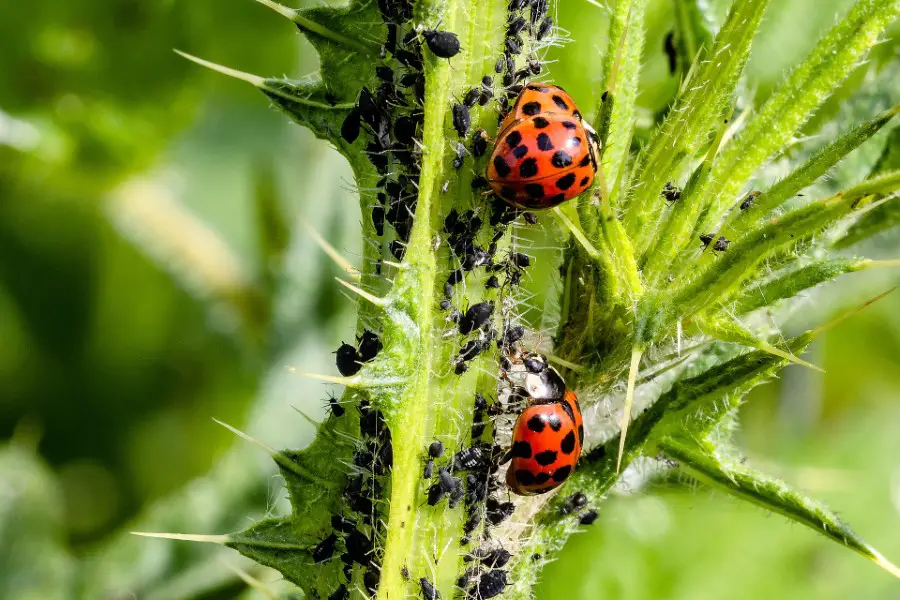
How Long Can Ladybugs Live Without Food?
While there has been no official testing on how long a ladybug can live without food, but personal experiences dictate that it’s not for long. Ladybugs exist on a high protein diet and can expend vast amounts of energy in flying and in producing toxins when threatened. It’s estimated that they cannot live more than two days without some form of food.
They need a constant source of food. Otherwise, they’ll begin to starve. The only time these insects are not actively searching for food and eating is when they’re hibernating.
The fact that a Ladybug can eat up to a hundred aphids in a day is a testament to the amount they must keep eating. And even during that stage, they keep using the energy they have preserved from storing up fat reserves during summer. prior to the overwintering stage.
Do Ladybugs Bite?
Well, ladybugs do actually bite. They have mandibles that are used to hold on to their prey. But these mandibles are so small that they are of no real danger to humans.
Remember, that an adult ladybug is 0.3 – 0.4 inches long only. Unless you have an allergic reaction to Ladybugs, they are unlikely to harm you, except maybe produce a small slightly red patch. But do all Ladybugs Bite?
Also, they do not have any poison glands or saliva. As a result, there’s no chance of a reaction, even if you do get bit. At the most, you’re likely to experience a small pinching sensation when they bite you. See this article for what to do if you’re bitten by a Ladybug.
How Long Can Ladybugs Live in a Jar or Container?
Ladybugs are friendly pets. Many store them in jars or containers. They are easy to catch and there’s not much needed in terms of maintenance in care. However, since they don’t tend to live long, you will need to refresh your pet population every year.
Take a small container about 4 inches by 7 inches to store the ladybugs. If you keep a small container then the bugs would not have to search far and wide for their food. Do not try to get a lot of bugs in one go, since you’ll have to provide food for them all and they do eat a lot for their size.
To get them into the container,
Put a leaf inside the container. The bugs will use the leaf to cling to it. Ladybugs don’t really drink water as we would normally expect them to. Place a wet paper towel inside the box. They’ll survive on the moisture in the towel. When the towel dries up, you can replace it with another wet paper towel.
Finally, collect aphids from your garden and put them inside the container. When the aphid supply depletes, reintroduce some into the box.
Alternatively, there is a specialist Ladybug Land Home Kit that you can obtain, which will provide a good home, food, and plenty to see as you study the life cycle of your Ladybugs. You can go straight to Amazon for them or find them with lots of other fabulous things on my gifts and resources page.
Alternatively, you could always have a go at making your own!
How Long Can Ladybugs Live in Winter? and How Do They Survive?
Ladybugs use the winter to hibernate. They can survive in extremely cold temperatures due to this ability. Often ladybugs can be found in some of the harshest conditions on the planet.
They’ll shut down their bodily functions so as to survive the winter. This is especially useful since aphids and their own natural food source and scarce during this time. However, the colder the winter, the harder it is to survive. Find out more about What Ladybugs Do in Winter.

How Long Do Ladybugs Live – Ladybug Life Cycle Conclusion
Ladybugs survive mostly for a year on average. However, they can go on to live longer lives as well. Their sustenance depends on a number of factors including availability of food, weather, species, temperature, etc. If all these factors give the ladybug a fruitful outlook, then she can expect to live for 2 years, even up to 3 in rare cases.
In places of extreme cold, they’re likely to survive for lower durations since they’ll have to hibernate longer. But then again, they’ll still resume activities once spring comes. They show incredible resilience for survival and are also known to be great pets.
I kind of wish they lived longer. I mean they’re so lovely to have around, it just seems a shame that their lives are so short. Or are they?
They might seem like short lives to us, but to a Ladybug, they might seem to last for ages – a lifetime in fact, compared to us, humans. I hope that is the case.
I also hope you’ve enjoyed this article, please feel free to share it from ladybugplanet.com if you did.
Also, don’t forget to take a look at my Ladybug Gifts and Resources page for some great little Ladybug Protection gifts, and check out Green kid Crafts for hands-on resources in your educational establishment or home school project.
Related Questions:
Is there a difference between lady beetles and ladybugs? Ladybugs are actually a more common name than lady beetles. However, they refer to the same insects. The name lady beetles came from the original name “Beetles of the Lady” referring to the Virgin Mary

